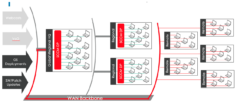Do I Need An Enterprise Content Delivery Network?
CMMA BlogThe demand for both rich digital media and software security updates can strain an enterprise network. Bottlenecks can form from WAN overload, causing employees to feel disconnected from the corporate community and leaving remote devices open to security breaches.
A software-defined Enterprise Content Delivery Network (SD ECDN) delivers all content—live and on-demand videos, software updates and more—to an entire network footprint at high speeds.
Peer-to-peer assisted technology avoids bottlenecks that occur in traditional content delivery methods.
Traditional methods of enterprise content delivery rely on sending packets to servers, called distribution points, which then send packets to individual endpoints. This means that content delivery is limited by hardware budgets, making it difficult to scale when network demand is high for live streaming CEO events or software migrations. End users will then experience constant buffering and poor network connections. IT may experience failed software deployments. Remote offices without dedicated distribution points will be out of luck altogether.
Intelligent peer-assisted technology provides a software-based network overlay that distributes content delivery. The top-down view of the network topology makes it possible for the ECDN to continuously adapt and optimize to changes before delivering content. The ECDN then picks the least resource dependent route to send packets to peers, thereby facilitating content delivery at high speeds. The adaptability of the network overlay also means it can scale without adding expensive hardware.
“We don’t necessarily care which peer to peer mechanism you put in place. We just recommend that you have one, in order to enable efficient distribution of these large packages that would be pushed around your network. With these in place, 90% of the traffic can be shifted away from that core distribution point and out to the edges of the network.”
Michael Niehaus
ECDN for a Scalable Video Ecosystem
Employees need access to messages from their leadership to help them understand the vision and strategy of the organization, to help them make smart decisions and to perform their jobs. They also want to feel connected to management and their globally dispersed workforce. Add to this the transformational change brought on by Millennials and how they choose to interact and consume information. The demand for video is real and now, pushing enterprises to establish stable and scalable video ecosystems.
A video ecosystem means a live video event team can stream live events such as a monthly CEO All Hands or Town Hall Meeting to a global audience. Additionally, human resources can use video to deliver high-quality training and video on-demand (VOD), avoiding expensive training and travel costs.
With an ECDN, this stream team becomes a dream team with live and on-demand video content being delivered seamlessly to all employees, regardless of their location, without impacting the network.
ECDN for Scalable Software Delivery
Enterprise IT teams need to understand their network, deliver content in a timely fashion and protect enterprise data and systems from constant security threats.
With the demise of Windows 7 , enterprises must push to migrate legacy systems to Windows 10. Migration, along with the new Windows as a Service (WaaS) model is bandwidth intensive. WaaS means IT will have to deal with bigger, more frequent updates. Businesses will no longer be able to decline updates. Rather, they will have to prepare and install an update within 180 days. This new update lifecycle establishes a baseline configuration for all Windows PCs on the network with the hope that this new policy will lead to fewer security breaches via vulnerable remote devices.
While the new update policy may seem daunting, an ECDN turns every networked device into a distribution point, moving bandwidth-intensive content from the WAN to the LAN. An ECDN, helps IT teams manage the accelerated updates , distribute updates to all endpoints, reduces the need for hardware and frees up FTEs to work on other organizational initiatives.

So, do you need an ECDN?
If your business has more than 5,000 employees in multiple locations that you want to communicate and collaborate with, while keeping secure, then yes, you need an ECDN. Through our customer support and services, our visually stunning and actionable analytics and our product that delivers any type of enterprise content to your endpoints, we believe our ECDN is the best in the market.
Want to lean more? Reach out and we’ll set up some time with one of our delivery experts to share how the Kollective ECDN works. Talk to an expert .
THE DEATH OF WINDOWS 7 REPROT
How today’s enterprises are preparing for tomorrow’s security disaster.
8 Ways to Boost Trust and Transparency in Your Organization
When employees and customers trust their leaders, a company is better able to weather crises and excels.
Related Blog Posts
Top Tips to Be an Authentic and Credible Speaker On Camera
Let me tell you, video is never easy to do well across an entire enterprise. I know first-hand as we host a mandatory monthly All Hands Meeting at Kollective. While my event services team can share details on the planning, logistics and technology that it takes to…
Successful Enterprise Live Video in APAC
A couple months ago I was fortunate enough to be able to travel to Asia to work on a couple customer events. Asia, and Japan in particular, have always been at the top of my bucket list. Kollective has offices in the region, and as our technology is able to deliver…
Live Enterprise Video Brings Out The Passion In Your Workforce
As the Enterprise Video Strategy Manager for Kollective in EMEA, I help our customers reach video success. I get the opportunity to engage with all the people involved in producing live events; whether they are speakers, owners, part of in-house production or hired…
The post Do I Need An Enterprise Content Delivery Network? appeared first on Kollective Technology .













